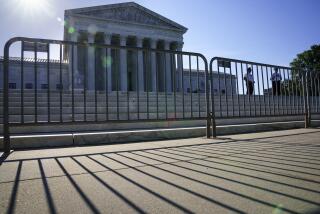When justices won’t go
- Share via
IT CAME AS something of a shock at the beginning of the summer when Chief Justice William H. Rehnquist announced that he would not be resigning from the Supreme Court. He is suffering from thyroid cancer, has had a tracheotomy to help him breathe and will be 81 years old at the start of the new court term. The smart money was on retirement.
But Supreme Court justices answer only to themselves and God when it comes to stepping down from the bench. Once Congress hath joined a nominee and his office, only death or retirement can separate them.
There is no evidence to suggest that Rehnquist’s poor health has affected his intellect, but the speculation over his absences last session and the course of his illness has reignited debate about a long-standing problem for the court: If a justice is significantly impaired, there is no way to remove him from the bench.
The Constitution provides for involuntarily removal of justices only by a process of impeachment. It requires a showing of serious wrongdoing but has nothing to do with mental competence. And yet since its founding, the court has struggled with incompetent, addicted and even insane justices.
In 1795, President Washington gave a recess appointment to John Rutledge of South Carolina to serve as chief justice. Washington was apparently unaware that Rutledge was mentally ill. Rutledge was described by one leading South Carolinian as prone to “mad frollicks,” and South Carolina Sen. Ralph Izard said Rutledge was “frequently so much deranged, as to be in a great measure deprived of his senses.”
According to Emory University law professor David Garrow, Rutledge tried repeatedly to drown himself in various rivers before finally resigning within a year of his appointment. (Notably, Rutledge’s confirmed successor, Justice William Cushing, was himself described as “much impaired” mentally and ultimately declined the position.)
And there are more:
* Henry Baldwin was confirmed in 1830, and within two years Daniel Webster warned of the “breaking out of Judge Baldwin’s insanity.” Baldwin missed the 1833 term, hospitalized for what was called “incurable lunacy.” He remained on the court for 11 more years.
* Justice Robert C. Grier’s problems were widely known among politicians and reporters in the mid-1800s. Historian David Atkinson notes that Grier could “scarcely function” due to physical and mental decline. Yet, in 1869 -- just days before Grier agreed to leave the bench under pressure from his colleagues -- Chief Justice Salmon Chase insisted on using the incompetent justice as the decisive vote to strike down a major federal law, the Legal Tender Act.
* In 1880, Justice Nathan Clifford was described by one of his colleagues as a “babbling idiot.” Newspapers called his seat “practically vacant” due to this illness. He refused to resign and died on the court.
* Serving with Clifford was Ward Hunt, who was left speechless and paralyzed after an illness. Yet he too refused to resign because he lacked the 10 years of service needed to earn a pension. Congress passed a law granting him a special pension to get him off the court.
Age or term limits are one obvious possible reform.
In a recent Fox News poll, two-thirds of Americans said they believe that there should be a mandatory retirement age for justices. Many justices have themselves called for an age limitation, including Justice Owen J. Roberts, who even complained to Congress that “superannuated” justices were unfit but “clung” to their offices.
Age, however, is a crude measure for mental competence. Baldwin was only 52 when signs of instability were detected, and Cushing was 63. And age may also have little to do with competency allegations.
By the time Justice Frank Murphy, a former U.S. attorney general who joined the court in 1940, was 57, he was addicted to drugs, including the painkiller Demerol. According to his biographer, Sidney Fine, Murphy bought illegal drugs twice a day when he was on the court. In 1981, Rehnquist’s staff admitted that he had developed a “physiological dependence” on a painkiller. Like Murphy, Rehnquist overcame his dependence and questions of competence.
There are ways to address such problems and still protect the justices’ independence.
We could amend the Constitution to allow for an automatic “reappointment vote” by the Senate. Physical or mental competence would be the only issues under consideration and disqualification would require a super-majority. Or we could create a hearing process, with independent judicial review of disability allegations.
As modern medicine extends the lives of everyone, including Supreme Court justices, these controversies are likely to grow. We must clearly proceed with caution in amending the Constitution and in reforming one of our most cherished institutions. The greater danger, however, would be to allow our high respect for the court as an institution to blind us to its flaws.
More to Read
Get the L.A. Times Politics newsletter
Deeply reported insights into legislation, politics and policy from Sacramento, Washington and beyond. In your inbox twice per week.
You may occasionally receive promotional content from the Los Angeles Times.










